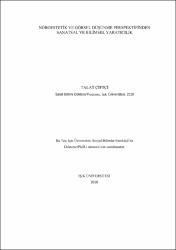Nöroestetik ve görsel düşünme perspektifinden sanatsal ve bilimsel yaratıcılık
Künye
Çiftçi, T. (2018). Nöroestetik ve görsel düşünme perspektifinden sanatsal ve bilimsel yaratıcılık. İstanbul: Işık Üniversitesi Sosyal Bilimler Enstitüsü.Özet
Sanat ve bilim alanlarındaki yaratıcılık ulusların rekabet gücünü oluşturmaktadır. Bu tez çalışmasında, Görsel Düşünme’nin yaratıcılıktaki rolünün ortaya çıkarılması hedeflenmiştir. Bu maksatla, beynin yapılaşması ile Gestalt, Nöroestetik ve Ayna Nöron kavramları incelenmiştir. Ayrıca, zihin modelleri ışığında beynin stratejik işlevleri ele alınmıştır. Sanat ve bilimin arakesitinde çalışan insanlar incelenerek, sanatsal ve bilimsel yaratıcılık arasındaki ilişki araştırılmıştır. Sahip olduğu görsel sanat eserleri ve iletişim yöntemleri, bir toplumun Görsel Okuryazarlık seviyesini belirlemektedir. Bu çalışmada, beynin yapılaşmasını yansıtan beş farklı stratejik bakış ile dış dünyanın gözlemlendiği ortaya çıkmıştır. Tarih boyunca oluşan sanat eserlerinden örnekler seçilerek, bu bakış açılarına göre Sanatın Periyodik Tablosu oluşturulmuştur. Sahip olunan Görsel-Uzamsal Zekâ, eğitim ve deneyimler, bireylerin özgün Görsel Düşünme yaklaşımlarını ortaya çıkarmaktadır. Önemli sanatsal ve bilimsel yaratıcılık örnekleri incelenerek, bu süreçlerde Görsel Düşünme’nin rolü tartışılmıştır. Özellikle sanat ve bilimin arakesitinde çalışan insanların hem sanat hem de bilim alanında çoklu beceriye sahip oldukları ortaya çıkmıştır. Bu tez çalışmasında ortaya çıkarılan bulgulara dayanarak, küresel rekabet için yeni bir inovasyon kültürünün oluşturulması gerektiği anlaşılmıştır. Bu amaçla, Görsel- Uzamsal Zekâ açısından seçkin gençler belirlenerek, özel olarak yetiştirilmesi planlanmalıdır. Ayrıca, lise eğitiminde Görsel Düşünme’nin öğretilmesi gerekmektedir. The creativity in arts and sciences determines the competitiveness of nations. In this thesis, the objective was the determination of the role of Visual Thinking in creativity. For this purpose, brain structure and the concepts of Gestalt, Neuroaesthetics and Mirror Neurons were studied. In addition, the strategic functions of the brain modules were investigated. The people in the crosssection of arts and sciences were analyzed to determine the similarities between the creativity in both areas. The visual techniques commonly used in arts and communication describe the level of the Visual Literacy of societies. In this study, it was determined that there are five different strategic perpectives of the external world. According to these perspectives, the visual artifacts from the various time periods were classified in the Periodical Table of Art. Visual-Spatial Intelligence together with education and experience affects the unique Visual Thinking approach of people. By analyzing important examples of artistic and scientific creativity, the role of Visual Thinking in the process was established. The people, who are actively working in the crossection of arts and sciences frequently demonstrate multiple competencies. According to the findings of this thesis work, there is a need for a novel innovation culture for global competitiveness. For this purpose, the students with high Visual- Spatial Intelligence should be identified and trained specifically for innovation. In addition, Visual Thinking techniques should be taught during high school education.



















